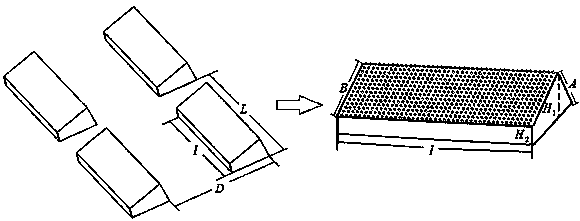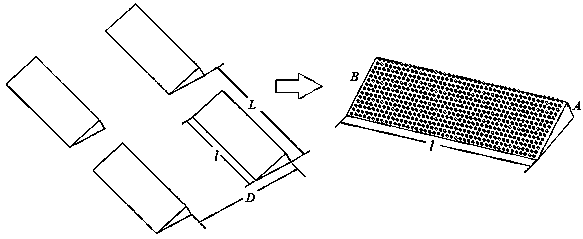Design method of anisotropic super-hydrophobic surface of common nepenthes-imitating sliding area
A super-hydrophobic surface and anisotropic technology, applied in design optimization/simulation, special data processing applications, etc., can solve problems such as lack of anisotropy, outdated bionic prototypes, etc.
- Summary
- Abstract
- Description
- Claims
- Application Information
AI Technical Summary
Problems solved by technology
Method used
Image
Examples
Embodiment 1
[0031] Embodiment 1: Step 1, characterize the micro-morphological structure parameters of the slip zone of Nepenthes. Using a scanning electron microscope and a three-dimensional white light interferometer to observe the surface microtopography of the slip zone of Nepenthes, and analyze and extract the characteristic parameters of the microtopography. Specifically include: the height, length, width, spacing, and density of the lunate body in the slip zone of Nepenthes, as well as the height and area ratio of the waxy crystal layer.
[0032] Nepenthes alata was selected as the bionic prototype, and the testing and characterization instruments used scanning electron microscope and three-dimensional white light shape interferometer. For Nepenthes red bottle leaf cages, samples with a length and width of 10 mm were cut from the slip area, dried by critical point drying, and then pasted on the experimental bench with double-sided adhesive tape; scanning electron microscopy and thre...
Embodiment 2
[0046] Embodiment 2: Step 1, characterizing the micro-morphological structure parameters of the slip zone of Nepenthes. Using a scanning electron microscope and a three-dimensional white light interferometer to observe the surface microtopography of the slip zone of Nepenthes, and analyze and extract the characteristic parameters of the microtopography. Specifically, it includes: the height, length, width, spacing, and density of the lunate body in the slip zone of Nepenthes, as well as the height and area ratio of the waxy crystal layer and other structural characteristics.
[0047]Nepenthes alata was selected as the bionic prototype, and the testing and characterization instruments used scanning electron microscope and three-dimensional white light shape interferometer. For Nepenthes red bottle leaf cages, samples with a length and width of 10 mm were cut from the slip area, dried by critical point drying, and then pasted on the experimental bench with double-sided adhesive ...
PUM
 Login to View More
Login to View More Abstract
Description
Claims
Application Information
 Login to View More
Login to View More - R&D
- Intellectual Property
- Life Sciences
- Materials
- Tech Scout
- Unparalleled Data Quality
- Higher Quality Content
- 60% Fewer Hallucinations
Browse by: Latest US Patents, China's latest patents, Technical Efficacy Thesaurus, Application Domain, Technology Topic, Popular Technical Reports.
© 2025 PatSnap. All rights reserved.Legal|Privacy policy|Modern Slavery Act Transparency Statement|Sitemap|About US| Contact US: help@patsnap.com



